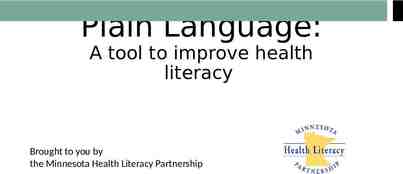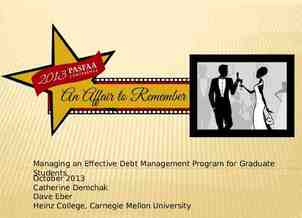A Safety & Health Curriculum For Young Workers New Jersey
51 Slides9.65 MB

A Safety & Health Curriculum For Young Workers New Jersey Edition DEPARTMENT OF HEALTH AND HUMAN SERVICES Centers for Disease Control and Prevention National Institute for Occupational Safety and Health

Lesson 1to Young Worker Introduction Injuries 2

You will learn about Ways young workers can get hurt on the job Common health and safety hazards on the job Ways to reduce or control workplace hazards Emergencies in the workplace and how to respond What to do if you see something at work that could hurt you or make you sick What legal rights and responsibilities young people have at work 3

What is Your Experience With Work? How many of you have ever had a job? Where did you work? What did you do? Have you ever been hurt at work, or do you know someone who has? Have you ever been uncomfortable with a task you’ve been asked to do at work? Have you ever had any health and safety training at work? 4

Job Safety Quiz The law says your employer is responsible for providing you with a safe and healthy workplace. True False The law sets limits on how late you can work on a school night if you are under 16. True False If you are 16 years old you are allowed to drive a car on public streets as part of your job. True False 5

Job Safety Quiz (continued) If you are injured on the job, your employer must pay for your medical care. True False How often do teens get injured on the job in the United States? One per day One per hour One every 9 minutes 6

Why are Young Workers More Likely to be Hurt on the Job? Video and Discussion 7

The Impact of Work Injuries Examples of Teen Work Injuries Jack’s Story Job: Fast food worker Hazard: Greasy, slippery floors Injury: Injured tailbone Why do you think this happened? What could have prevented Jack from getting hurt? How might this injury impact Jack’s daily life? 8

The Impact of Work Injuries Teen Work Injuries Job: Antonio’s Story Construction helper Hazard: Unguarded chimney hole (on an unfinished roof) Injury: Broken back Why do you think this happened? What could have prevented Antonio from being injured? How might this injury impact Antonio’s daily life? 9

The Impact of Work Injuries Teen Work Injuries Job: Angela’s Story Office worker Hazard: Excessive typing in an awkward position Injury: Repetitive stress injury Why do you think this happened? What could have prevented Angela from being injured? How might this injury impact Angela’s daily life? 10

The Impact of Work Injuries Teen Work Injuries Job: Terrell’s Story Landscape worker Hazard: Wood chipper Injury: Death Why do you think this happened? What could have prevented Terrell from being killed? 11

The Impact of Work Injuries Teen Work Injuries Cody’s Story Job: Farm worker Hazard: Tractor without roll bar Injury: Legs crushed under tractor Why do you think this happened? What could have prevented Cody from getting hurt? How might this injury impact Cody’s daily life? 12

The Impact of Work Injuries Teen Work Injuries Job: Lindsey’s Story Pizza shop cashier Hazard: Violence (by a coworker) Injury: Bumps and bruises caused by abusive coworker What could Lindsey's employer have done to stop her abuser? What would you do in this situation? How might Lindsey’s life be affected by this incident? 13

The Impact of Work Injuries Teen Work Injuries Anna’s Story Job: Smoothie shop worker Hazard: Sexual harassment Injury: Emotional trauma What could Anna's employer have done to stop her harasser? What would you do in this situation? How might Anna’s life be affected by this incident? 14

The Impact of Work Injuries Teen Work Injuries Job: Logan’s Story Farm worker Hazard: Unguarded, rotating bar on a tractor Injury: Severed arm, broken neck Why do you think this happened? What could have prevented Logan from being injured? How might this injury impact Logan’s daily life? 15

Teen Worker Injury Statistics Approximately 1.6 million teens (aged 15–17) in the United States work. About 50% of 10th graders and 75% of 12th graders have jobs. Many youths are injured on the job. On average, each year 59,800 workers younger than 18 are sent to the ER for job-related injuries, but actual injury statistics are much higher. 37 workers younger than 18 die on the job. Young workers are twice as likely to be injured than adult workers. NIOSH 2010 www.cdc.gov/niosh/topics/youth/chartpackage.html www.cdc.gov/mmwr/preview/mmwrhtml/mm5915a2.htm 16

Teen Worker Statistics 50% 45% 44% Where Teens Work: 40% % of total workers, aged 15-17, per industry 35% 30% 24% 25% 20% 15% 8% 10% 6% 5% 0% Leisure and hospitality* Retail trade Educational and health services Other services 5% 7% 4% 2% Professional Agriculture, Manufacturing and business forestry, fishing services and hunting 1% Finance and insurance Other *Includes restaurants Based on national data, and may vary by state. Working teens under age 14 not represented. Youth farm workers not represented. Source: NIOSH / CDC 2009 (www.cdc.gov/niosh/topics/youth/chartpackage.html) 17

Teen Worker Injury Statistics 50% Where Teens are Injured on the Job: 45% 40% 38% 35% % of total workers, aged 15-17, per industry 30% 25% 21% 20% 15% 11% 10% 10% 9% 5% 0% 3% Leisure and hospitality* Retail trade Professional and business services Educational and health services Other services 2% 2% Finance and Agriculture, Manufacturing insurance forestry, fishing and hunting 4% Other *Includes restaurants. These data are for injuries that require at least one day away from work. They do not include youth who work on small farms, work for government agencies, or are self-employed. Source: NIOSH / CDC 2009 (www.cdc.gov/niosh/topics/youth/chartpackage.html) 18

Key Points of the Curriculum By the end of the course, you will be able to Recognize and reduce hazards on the job Identify the laws that protect teens from working too late or too long Identify the laws that protect teens from doing dangerous work Identify the laws that protect teens from discrimination (including harassment) at work Assess ways to solve health and safety problems at work Name some of the agencies that enforce health and safety laws and child labor laws Determine what to do in an emergency 19

Lesson 2 (and 2B) Finding Hazards 20

Job Hazards A job hazard is anything at work that can hurt you either physically or mentally. Safety hazards can cause immediate injuries Knives, hot grease Chemical hazards are gases, vapors, liquids, or dusts that can harm your body Cleaning products, pesticides 21

Job Hazards (continued) Biological hazards are living things that can cause sickness or disease, such as HIV/AIDS, hepatitis, tuberculosis. Bacteria, viruses Other health hazards are other harmful things that can injure you or make you sick. Some are not obvious because they may not cause health problems right away. Noise, radiation, repetitive movements, heat, cold, stress, violence 22

Illustrated Workplaces Find The Hazards: Fast Food Restaurant a 23

Illustrated Workplaces Find The Hazards: Grocery Store a 24

Illustrated Workplaces Find The Hazards: Office a 25

Illustrated Workplaces Find The Hazards: Gas Station a 26

Hazard Mapping Activity 27

Finding Hazards: Main Points All workplaces have hazards. A job hazard is anything at work that can hurt you, physically or mentally. Some job hazards are obvious, but others are not. Some hazards can hurt you now, others can hurt you in the future. To be safe on the job, you must identify different types of hazards. People have a right to know about chemicals and other hazardous substances in their workplaces! When using a new chemical, read labels and check the SDS (Safety Data Sheet). 28

Lesson 3 (and 3B) Making the Job Safer 29

Controlling Hazards Remove the Hazard 2000 (for example, use safer chemicals, use a machine guard) Improve a Work Policies & Procedures 1000 (for example, conduct training, assign enough people to do the job) Wear Personal Protective Equipment (PPE) 500 (for example, wear gloves, use a respirator) 30

25,000 Safety Pyramid Game Eliminating or Reducing Hazards Job: Jasmin’s Story Hospital dishwasher Hazard: Chemical dishwashing solution Injury: Chemical burn to the eye 31

25,000 Safety Pyramid Game Eliminating or Reducing Hazards Will’s Story Job: Fast food worker Hazard: Hot grill Injury: Burned hand 32

25,000 Safety Pyramid Game Eliminating or Reducing Hazards Job: Andre’s Story Grocery store clerk Hazard: Lifting heavy boxes Injury: Back strain 33

25,000 Safety Pyramid Game Eliminating or Reducing Hazards Molly’s Story Job: Grocery store deli clerk Hazard: Meat slicer Injury: Cut finger 34

25,000 Safety Pyramid Game Eliminating or Reducing Hazards Chris’s Story Job: City public works employee Hazard: Excessive heat Injury: Heat stroke 35

25,000 Safety Pyramid Game Eliminating or Reducing Hazards Job: James’s Story Pizza shop employee Hazard: Repetitive motion Injury: Hand, back injury 36

25,000 Safety Pyramid Game Eliminating or Reducing Hazards Job: Maria’s Story Farm worker Hazard: Pesticide/chemical exposure Injury: Illness due to poisoning 37

25,000 Safety Pyramid Game Eliminating or Reducing Hazards Jada’s Story Job: Nursing aide Hazard: Heavy lifting Injury: Back, neck, and shoulder pain 38

25,000 Safety Pyramid Game Eliminating or Reducing Hazards Anita’s Story Job: Barista Hazard: Hot liquids Injury: Burn 39

Making the Job Safer: Main Points The best way to prevent a workplace injury or illness is to remove the hazard. If this can’t be done, then hazards can be controlled through work policies and procedures or the use of PPE (personal protective equipment), such as a respirator or hearing or eye protection. Personal protective equipment is not usually the best way to protect workers because the hazard is still there, and because the equipment has to fit right and be used every time. A good way to think about addressing hazards in the workplace is, “Fix the workplace, not the worker.” 40

Lesson 4 (and 4B) Emergencies at Work 41

Emergencies at Work What is an emergency at work? An unplanned event that harms or threatens employees, customers, or the public; that shuts down business operations; or that causes physical or environmental damage 42

Emergencies at Work Disaster Blaster! Game 43

Emergency Action Plans Many workplaces need an emergency action plan. Workers should receive training on the plan. The plan should include information about Different emergencies and how to respond Locations of meeting places Evacuation routes Emergency equipment and alert systems Key personnel (who’s in charge) Procedures to follow when someone is injured Individual worker responsibilities Practice drills 44

Lesson 5 (and 5B) Know Your Rights and Responsibilities 45

Know Your Rights: Quiz Game Questions Rights on the Job Dangerous Work and Work Permits Child Labor Laws and Work Hours Getting hurt, Getting help, Staying safe 100 100 100 100 200 300 400 This type of says insurance Your employer must give The law that It’s illegal for teens under NJ law says that this is NJ law says that this is NJ law says that pays wages and medical 200 When you turn These laws protect teens 200 This federal agency You can stay safe atunder work you these health and These are two rights you your employer must pay Some states require teens It’s illegal for teens Workers These 18 to do have federal these rights agencies types on the of the latest time teens 16 It’s illegal for 14-and 15It’s illegal for your You have to be this old to If you are hurt at work, the maximum number of 14and 15-year-olds can benefits for workers hurt this age, you aren’t from handles complaints about by doing these things safety protections on the have if you’re hurt on the you this amount per hour, under 18 and still in school 18 job, handle construction including complaints these work (name (name about and 17 can work on school year olds to do some jobs, employer to punish you operate atake forklift. you should these hours 14and 15 year-olds work until this time on on the job. In exchange, protected anymore by working too long, too late, wages and work hours. (name 2). job job. your state’s minimum to get this before starting to operate these machines workplace 2). 2). health and 300 300 nights. including these (name 2). for doing this can insteps agives school week. aor school night. thework worker up the child labor laws. too early. (name 2). wage. a job.2). (name Click to close safety. Click toclose close Click Click to close to close (name Click to close (name 2). Click to Click to close Click to close Click to close right to sue the1). Click to close employer. 400 Click to close Click totoclose Click close Click to close Click to close Click to close Click to close Click to close 400 200 300 400 Click to close 500 500 500 500 46

Know Your Rights: Main Points OSHA laws protect workers from job hazards. Employers must provide a safe and healthy workplace, training, and safety equipment. Tell your supervisor right away if you’re injured at work! You can’t be fired for reporting work hazards. Departments of Labor enforce child labor laws. The Equal Employment Opportunity Commission (EEOC) protects workers from discrimination and harassment at work. Child labor laws protect teens from working too long, too late, too early, or in certain dangerous jobs. Young people have rights and responsibilities at 47

Know Your Rights Labor Law Bingo Game 48

Lesson 6 (and 6B) Taking Action 49

How to Approach a Workplace Problem Steps in Problem Solving Define the problem. Get advice. Choose your goals. Know your rights. Decide the best way to talk to the supervisor. Contact a state or federal Wage & Hour Division or OSHA for help, if necessary. Talk to a teacher, parent, co-worker, or other trusted adult. 50

Taking Action: Main Points Steps for approaching a workplace problem include: defining the problem; getting advice; choosing goals; knowing your rights; talking to your supervisor. If you don’t feel comfortable talking with your boss, speak with a trusted adult, OSHA, or another agency. Trust your instincts! Don’t be afraid to speak up if you have a problem at work! 51






